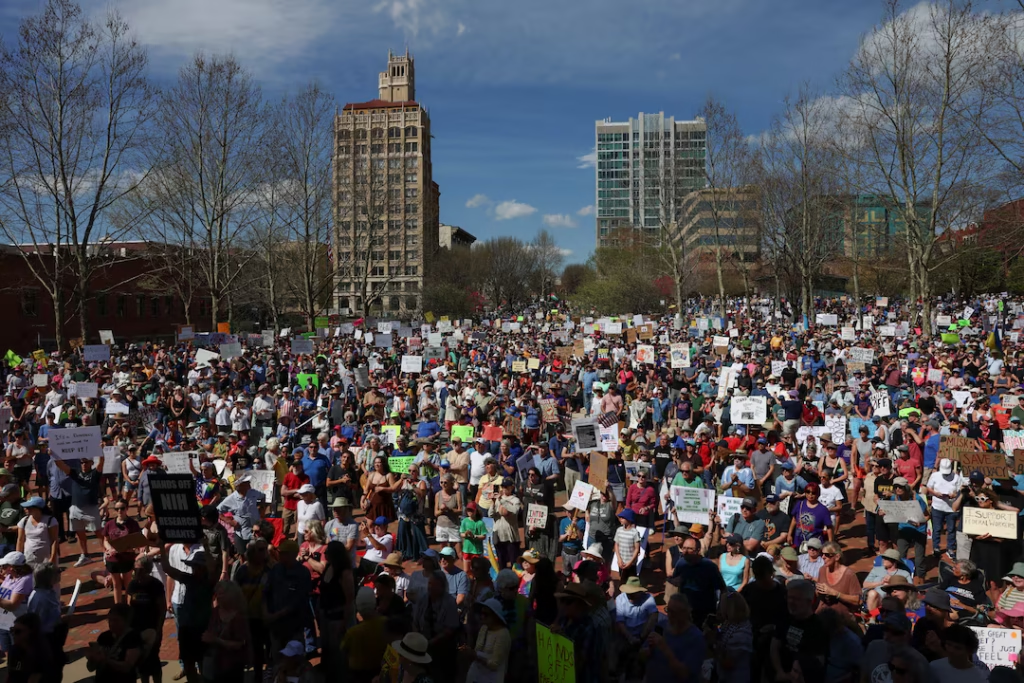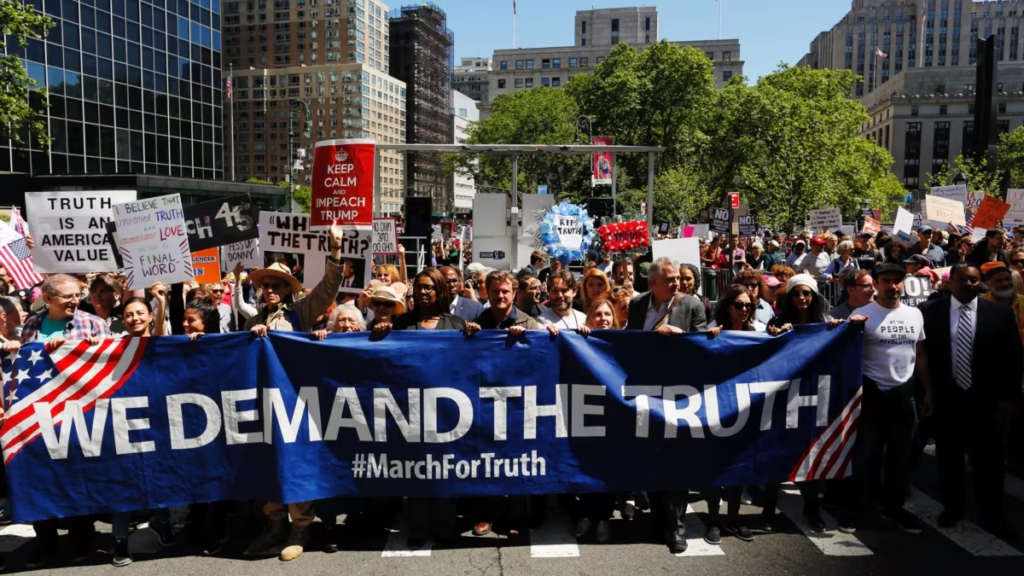Tens of thousands of Americans took to the streets across the United States and in cities abroad on Saturday in one of the largest coordinated protest actions since President Donald Trump returned to office. The protests, organized across all 50 states and internationally, focused on the administration’s controversial DOGE (Department of Government Efficiency) initiative, economic policies, and efforts to consolidate executive power.

In Washington, D.C., demonstrators gathered by the tens of thousands on the National Mall despite rainy skies. The rally at the Washington Monument was one of over 1,200 planned events. Organizers reported that more than 150 activist groups had joined forces for the movement, with satellite demonstrations held in Canada, Mexico, and major European capitals.
Among the protesters was Terry Klein, a retired scientist from New Jersey, who criticized Trump’s policies on immigration, education, and tariffs. “Our entire country—our institutions, our values—are under attack,” she said.
Throughout the day, demonstrators waving Palestinian keffiyehs and Ukrainian flags called for justice on global issues, while lawmakers from the Democratic Party denounced Trump’s agenda on stage. Many held signs reading “Save Social Security” and “Stop DOGE Cuts,” voicing concerns over the elimination of federal jobs and social benefits.
Wayne Hoffman, a retired financial adviser from New Jersey, warned that Trump’s trade policies and widespread tariff usage could devastate the economy. “Farmers are going to lose their livelihoods, retirement accounts are collapsing, and jobs are disappearing,” he said.
While the protests were mostly peaceful, some Trump supporters engaged in debate along the rally’s periphery. Kyle, a 20-year-old intern from Ohio, donned a MAGA hat and said he felt isolated but was eager to talk with opponents. “Some people get angry, but many just want to talk,” he noted.
In Florida, President Trump spent the day golfing at his Jupiter club, returning later to Mar-a-Lago. Just a few miles away in West Palm Beach, more than 400 demonstrators rallied, chanting slogans like “Markets crash, Trump golfs.”

Similar protests occurred in Stamford, Connecticut, where 84-year-old Sue-ann Friedman decried the administration’s proposed cuts to medical research. “I never thought I’d be protesting again at this age,” she said.
Paul Kretschmann, 74, a retired attorney also protesting for the first time, voiced deep fears over the future of Social Security. “This is part of a broader effort to dismantle the government and let Trump retain control,” he warned.
The Department of Government Efficiency, backed by Elon Musk and Trump, has laid off over 200,000 federal workers in recent months. On Friday, the IRS began shedding 20,000 staff—approximately 25% of its workforce.
Near Baltimore, protesters gathered outside the Social Security Administration headquarters to oppose what they see as efforts to dismantle the agency that supports millions of elderly and disabled Americans.
Linda Falcao, 64, spoke passionately about paying into the system since she was 16. “I’m heartbroken. I need the benefits I was promised. It’s our money!” she declared, as the crowd echoed her cry.
In response, White House Assistant Press Secretary Liz Huston defended the administration. “President Trump remains committed to protecting Social Security, Medicare, and Medicaid. Democrats, meanwhile, are pushing to extend benefits to illegal immigrants, which would bankrupt these vital programs,” she said.
Many aspects of Trump’s second-term agenda have faced legal challenges, with courts reviewing his attempts to fire civil servants, restrict immigration, and roll back LGBTQ+ protections. Critics link the president’s aggressive moves to Project 2025, a conservative blueprint to transform U.S. governance and concentrate power in the executive branch.
Solidarity protests also broke out in Europe. American expatriates demonstrated in Berlin, Paris, Frankfurt, and London, condemning the administration’s foreign policy shifts and rollback of civil rights.
As opposition grows both at home and abroad, the Trump administration continues to push forward with its transformative policies—polarizing the nation and fueling unprecedented levels of civic activism.



